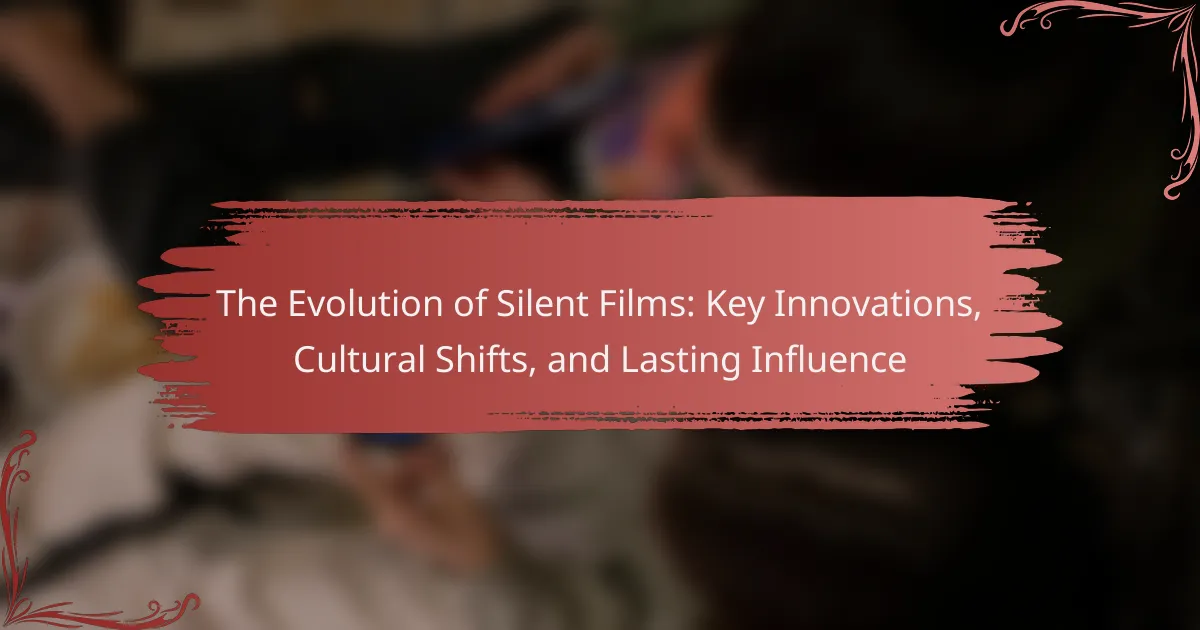Silent films are motion pictures created without synchronized sound, particularly dialogue, emerging in the late 19th century and peaking in the 1920s. Key innovations in this genre include the use of intertitles, expressive visual storytelling, and advanced cinematography techniques, which shaped early filmmaking. Silent films significantly influenced cultural dynamics, transforming entertainment and societal norms while fostering global communication. The transition to sound films began with “The Jazz Singer” in 1927, marking the end of the silent film era but establishing a legacy that continues to impact modern cinema through narrative and visual techniques.

What are Silent Films and Their Historical Context?
Silent films are motion pictures without synchronized sound, primarily dialogue. They emerged in the late 19th century, around the 1890s. Early examples include “The Great Train Robbery” (1903) and “A Trip to the Moon” (1902). Silent films relied on visual storytelling, intertitles, and live music to convey narratives. The period of silent films peaked in the 1920s, showcasing innovations in cinematography and editing. The transition to sound films began in 1927 with “The Jazz Singer,” marking the end of the silent film era. Silent films reflect cultural contexts of their time, addressing societal issues and entertainment trends. They laid the groundwork for modern filmmaking techniques and narrative structures.
How did silent films emerge as a significant form of entertainment?
Silent films emerged as a significant form of entertainment in the early 20th century. They became popular due to advancements in film technology and storytelling techniques. The introduction of longer film reels allowed for more complex narratives. The use of intertitles provided essential dialogue and context for viewers. Additionally, live music accompaniment enhanced the emotional impact of silent films. The 1910s saw the rise of iconic stars like Charlie Chaplin and Buster Keaton, drawing audiences to theaters. By the 1920s, silent films dominated the entertainment industry, with major studios producing high-quality content. The cultural shift towards visual storytelling further solidified their significance.
What technological advancements enabled the creation of silent films?
The technological advancements that enabled the creation of silent films include the development of motion picture cameras and film stock. The invention of the motion picture camera in the late 19th century allowed filmmakers to capture moving images. Early cameras, like the Kinetoscope, were pivotal in this process. The use of flexible film stock improved the quality and durability of recordings. Additionally, the introduction of editing techniques allowed filmmakers to piece together scenes effectively. The synchronization of visual storytelling with live music enhanced audience engagement. These advancements collectively laid the foundation for the silent film era, which flourished from the 1890s to the late 1920s.
How did early cinema reflect the cultural landscape of its time?
Early cinema reflected the cultural landscape of its time by portraying societal norms and values. Films often depicted everyday life, highlighting the struggles and aspirations of the common people. For example, the rise of the working class was a common theme in silent films. They showcased the impact of industrialization and urbanization on society. Additionally, early cinema captured significant historical events, such as wars and social movements. This provided audiences with a visual representation of their realities. The use of humor and melodrama also mirrored the emotional landscape of the era. Overall, early cinema served as a mirror to the evolving cultural dynamics of the early 20th century.
Why were silent films important in the evolution of cinema?
Silent films were crucial in the evolution of cinema as they established foundational storytelling techniques. They introduced visual narratives that relied on expressions and gestures. This form of cinema allowed filmmakers to experiment with editing and shot composition. Silent films also paved the way for genres such as comedy, drama, and horror. The era saw significant innovations like the use of intertitles to convey dialogue and plot. Iconic silent film stars, such as Charlie Chaplin and Buster Keaton, became cultural icons. Their work influenced future generations of filmmakers and actors. The transition to sound in films built upon the narrative techniques developed during the silent era.
What role did silent films play in shaping modern filmmaking techniques?
Silent films were foundational in developing modern filmmaking techniques. They established visual storytelling through expressive acting and innovative cinematography. Directors like D.W. Griffith pioneered editing techniques such as cross-cutting and close-ups. These methods enhanced narrative pacing and emotional engagement. The use of title cards for dialogue influenced screenwriting and dialogue delivery in sound films. Additionally, silent films emphasized the importance of mise-en-scène, influencing set design and composition in later cinema. The transition to sound films built upon these visual techniques, ensuring their lasting impact on the industry.
How did silent films influence audience engagement and storytelling?
Silent films significantly influenced audience engagement and storytelling by relying on visual expression and intertitles. The absence of spoken dialogue required filmmakers to convey emotions through [censured] expressions and body language. This visual storytelling engaged audiences more deeply, as viewers had to interpret actions and emotions without verbal cues.
Additionally, silent films often used dramatic music scores to enhance emotional impact. This combination of visuals and music created a more immersive experience for audiences. According to film historian David Bordwell, silent films fostered a unique form of audience interaction, as viewers actively constructed meaning from the images presented.
Moreover, the use of intertitles helped to clarify plot points and dialogue, allowing for a fluid narrative flow. This innovation in storytelling techniques laid the groundwork for future cinematic practices. Silent films thus transformed how stories were told and experienced, establishing a foundation for modern filmmaking.

What Key Innovations Defined Silent Films?
Key innovations that defined silent films include the use of intertitles, visual storytelling, and innovative cinematography. Intertitles provided dialogue and context, enhancing narrative clarity. Visual storytelling relied on expressive acting and gestures to convey emotions. Innovative cinematography techniques, such as close-ups and creative framing, captured audience attention. These innovations were crucial in the early 20th century, as silent films relied on visual elements due to the absence of synchronized sound. The introduction of synchronized scores and sound effects in some silent films further enriched the viewing experience. These advancements laid the groundwork for the transition to sound films in the late 1920s.
What are the major technological innovations in silent filmmaking?
Major technological innovations in silent filmmaking include the introduction of the motion picture camera, which captured images in rapid succession to create the illusion of movement. The use of film stock improved image quality and allowed for longer recording times. The development of editing techniques enabled filmmakers to splice together different scenes seamlessly. Intertitles were introduced to convey dialogue and narrative, enhancing storytelling. The advent of synchronized sound systems allowed for better integration of music and sound effects, although complete synchronization was not achieved until later. Innovations in lighting techniques improved visibility and mood in films. The introduction of color processes, such as tinting and hand-coloring, added visual appeal. These advancements significantly shaped the silent film industry and influenced future filmmaking techniques.
How did the introduction of intertitles enhance storytelling in silent films?
The introduction of intertitles significantly enhanced storytelling in silent films. Intertitles provided essential context and dialogue that silent visuals could not convey alone. They allowed filmmakers to express complex narratives and emotions clearly. By using intertitles, filmmakers could guide audience interpretation and engagement. This innovation increased the emotional impact of scenes. Intertitles also facilitated character development through direct speech representation. Historical examples include the use of intertitles in films like “The Birth of a Nation” (1915), which employed them to clarify plot points. Overall, intertitles became a crucial tool for narrative clarity and audience connection in silent cinema.
What impact did live music and sound effects have on silent film viewership?
Live music and sound effects significantly enhanced silent film viewership. They created an emotional atmosphere that engaged audiences more deeply. The combination of visuals and live audio helped convey mood and tone. This synergy made films more entertaining and accessible. Historical records show that theaters employed musicians to accompany screenings. The presence of live music often influenced audience attendance and ticket sales. Sound effects added realism, making scenes more impactful. Overall, these elements transformed silent films into a more immersive experience.
How did silent film directors innovate within the medium?
Silent film directors innovated within the medium by developing unique storytelling techniques. They utilized visual storytelling to convey emotions and narratives without dialogue. Directors like D.W. Griffith pioneered the use of close-ups and cross-cutting. These techniques enhanced dramatic tension and audience engagement. Innovations in set design and lighting created immersive environments. The introduction of intertitles provided essential context and dialogue cues. Directors also experimented with special effects, such as stop-motion and double exposure. These advancements expanded the creative possibilities of silent cinema.
What unique cinematic techniques were pioneered during the silent film era?
Unique cinematic techniques pioneered during the silent film era include the use of title cards, expressive acting, and innovative camera angles. Title cards provided dialogue and context, bridging gaps in storytelling. Expressive acting emphasized physical gestures and [censured] expressions to convey emotions without sound. Innovative camera angles, such as close-ups and tracking shots, enhanced visual storytelling. Techniques like montage editing created emotional impact through juxtaposition of images. These innovations laid the groundwork for modern filmmaking practices. Silent films showcased creativity in conveying narratives without spoken words.
How did editing styles evolve in silent films?
Editing styles in silent films evolved significantly from basic cuts to more complex techniques. Early silent films primarily utilized simple continuity editing. This approach aimed to maintain a coherent narrative flow. As filmmakers gained experience, they began experimenting with techniques like cross-cutting. Cross-cutting allowed simultaneous action to be shown in different locations.
By the 1920s, filmmakers like Sergei Eisenstein introduced montage editing. Montage emphasized emotional impact through rapid image juxtaposition. This technique transformed storytelling by creating meaning beyond the individual shots. The transition to sound films in the late 1920s further influenced editing styles.
Silent film editing laid the groundwork for modern cinematic techniques. The evolution of editing styles reflected advancements in technology and artistic expression.

What Cultural Shifts Accompanied Silent Films?
Silent films led to significant cultural shifts in society. They transformed entertainment by providing a new medium for storytelling. Audiences became more engaged with visual narratives and expressive performances. This shift also contributed to the rise of celebrity culture, as actors gained fame and recognition.
Additionally, silent films influenced social norms and behaviors. They often depicted contemporary issues, reflecting societal changes and challenges. The popularity of silent films encouraged the development of movie theaters as communal spaces. This created a shared cultural experience among diverse audiences.
Moreover, silent films played a role in the globalization of culture. They transcended language barriers, allowing stories to reach international audiences. The visual nature of silent films fostered a new form of communication and artistic expression. Overall, silent films significantly impacted cultural dynamics and societal interactions.
How did silent films reflect societal changes and cultural movements?
Silent films reflected societal changes and cultural movements by portraying contemporary issues and evolving social norms. They often depicted themes such as class struggle, gender roles, and racial dynamics. For example, films like “The Birth of a Nation” showcased the racial tensions of the time, while “The Kid” highlighted the struggles of the working class. Silent films also mirrored the changing roles of women, as seen in the rise of strong female characters during the suffragette movement. The visual storytelling of silent films allowed audiences to engage with complex societal issues without spoken dialogue. This medium became a platform for social commentary, influencing public perception and cultural attitudes. The global reach of silent films further amplified their impact, as they united diverse audiences around shared experiences and challenges.
What themes were prevalent in silent films that resonated with audiences?
Silent films often featured themes of love, adventure, and social struggle. These themes resonated with audiences due to their universal appeal. Love stories showcased emotional connections, drawing viewers in. Adventure films provided excitement and escapism, captivating audiences with thrilling narratives. Social struggles reflected real-life issues, allowing viewers to relate to the characters’ challenges. The simplicity of visual storytelling made these themes accessible. Iconic films like “The Kid” and “City Lights” exemplified these themes effectively. The emotional depth and relatable situations contributed to silent films’ lasting popularity.
How did silent films contribute to the rise of celebrity culture?
Silent films significantly contributed to the rise of celebrity culture by popularizing actors as public figures. The absence of synchronized sound made visual performance crucial, leading to a focus on expressive body language and [censured] expressions. This visual emphasis allowed audiences to form strong emotional connections with actors. Iconic stars like Charlie Chaplin and Greta Garbo emerged, captivating viewers and creating dedicated fan bases. The lack of sound also meant that actors could be marketed universally, transcending language barriers. Film studios capitalized on this by promoting their stars through various media. The combination of visual storytelling and strategic marketing laid the foundation for modern celebrity culture.
What was the global impact of silent films on cinema?
Silent films significantly shaped the global landscape of cinema. They established foundational storytelling techniques that are still used today. The absence of synchronized sound pushed filmmakers to innovate with visual storytelling. This led to the development of expressive acting and dynamic cinematography. Iconic silent films like “The Birth of a Nation” and “Metropolis” influenced future genres and styles. Silent cinema also fostered international collaboration and cultural exchange. For example, filmmakers from different countries adopted and adapted techniques from one another. The global reach of silent films helped to create a shared cinematic language. This laid the groundwork for the later success of sound films and modern cinema.
How did silent films influence film industries in different countries?
Silent films significantly influenced film industries worldwide by establishing foundational cinematic techniques and storytelling methods. In the United States, silent films popularized the use of close-ups and cross-cutting, enhancing emotional engagement. European countries, like Germany and France, adopted these techniques while incorporating their cultural narratives. German Expressionism emerged, characterized by stylized visuals and themes of existentialism, influencing horror and drama genres globally. In Italy, the silent era led to the development of neorealism, focusing on real-life stories and social issues. The global distribution of silent films facilitated cultural exchange, inspiring filmmakers across continents. This exchange fostered innovation and diversity in cinematic language, shaping the evolution of film as an art form. Silent films laid the groundwork for the transition to sound, which further transformed the industry.
What role did silent films play in the spread of cultural narratives?
Silent films played a crucial role in the spread of cultural narratives by transcending language barriers. They utilized visual storytelling techniques to convey complex emotions and ideas. This allowed diverse audiences to engage with shared themes, such as love, conflict, and morality. Iconic films like “The Birth of a Nation” and “The Cabinet of Dr. Caligari” influenced societal perceptions and cultural discussions. The use of intertitles further enhanced understanding by providing context without relying heavily on spoken dialogue. Silent films also popularized cultural tropes and archetypes that resonated globally. Their impact on early cinema laid the groundwork for future storytelling methods in film. Overall, silent films were instrumental in shaping cultural narratives across different societies.

What is the Lasting Influence of Silent Films on Modern Cinema?
Silent films have significantly influenced modern cinema through storytelling techniques and visual expression. The absence of sound in silent films necessitated strong visual narratives. This led to the development of expressive acting and innovative cinematography. Directors like D.W. Griffith pioneered techniques such as close-ups and cross-cutting. These methods are still foundational in contemporary filmmaking. Silent films also emphasized the importance of visual cues and body language. This focus remains crucial in modern storytelling, especially in genres like action and animation. The legacy of silent films is evident in the way filmmakers today blend visual artistry with narrative depth.
How do silent film techniques still resonate in contemporary filmmaking?
Silent film techniques resonate in contemporary filmmaking through visual storytelling and expressive performances. Filmmakers today often emphasize imagery and body language over dialogue. This approach enhances emotional impact and audience engagement. Techniques such as exaggerated [censured] expressions and physical comedy stem from silent film traditions. Additionally, the use of intertitles for conveying essential information can be seen in some modern films. Cinematic techniques like montage and visual symbolism also trace their roots back to silent cinema. The influence is evident in genres such as animation and experimental films that prioritize visual narrative. This legacy showcases the enduring power of silent film techniques in shaping modern cinematic language.
What elements of silent films can be found in modern films?
Modern films incorporate several elements from silent films. Visual storytelling remains a core component. Filmmakers use expressive [censured] expressions and body language to convey emotions. This technique enhances audience engagement without dialogue. Additionally, intertitles are sometimes used in modern films for emphasis or clarity. The use of music to set the tone is also prevalent. Soundtracks often mimic the emotional cues found in silent film scores. Moreover, many modern films utilize exaggerated acting styles reminiscent of silent cinema. This approach can create a heightened sense of drama. Overall, these elements demonstrate the lasting influence of silent films on contemporary filmmaking.
How has the legacy of silent films shaped film theory and criticism?
The legacy of silent films has significantly influenced film theory and criticism. Silent films introduced fundamental concepts such as visual storytelling and mise-en-scène. These elements became essential in understanding cinematic language. Critics and theorists have often referenced silent cinema to highlight the power of imagery over dialogue. The emotional expressiveness of silent film actors set a precedent for performance analysis. Additionally, the techniques of editing and montage pioneered during this era informed later theoretical frameworks. Scholars like Sergei Eisenstein drew from silent film practices to develop concepts of montage in film theory. The absence of sound in silent films emphasized the importance of visual composition, leading to deeper analyses of framing and shot selection. Overall, silent films laid the groundwork for modern film critique and theory.
What lessons can filmmakers learn from the silent film era?
Filmmakers can learn the importance of visual storytelling from the silent film era. Silent films relied heavily on expressive visuals and body language to convey emotions. This approach emphasizes the need for strong visual composition in modern filmmaking. Filmmakers should also appreciate the power of pacing and timing. Silent films often used rhythm to enhance storytelling, which can still be effective today. Additionally, filmmakers can learn about the significance of creativity in overcoming technical limitations. Silent filmmakers innovated with techniques like montage and intertitles to engage audiences. These lessons highlight the enduring value of storytelling fundamentals in cinema.
How can the storytelling methods of silent films inspire current filmmakers?
Silent films utilized visual storytelling techniques that can inspire current filmmakers. They relied heavily on expressive performances and visual cues to convey emotions and narratives. This approach encourages filmmakers to focus on visual storytelling rather than dialogue.
Silent films often used intertitles to provide context, which can inspire current filmmakers to incorporate text creatively. They also emphasized strong character development through visual means, demonstrating the importance of non-verbal communication.
The simplicity of silent storytelling can lead to more universal narratives that resonate across cultures. Filmmakers can learn from the pacing and rhythm of silent films, which often created tension and engagement without spoken words.
Overall, silent films showcase how powerful visual storytelling can be, urging contemporary filmmakers to explore similar techniques in their work.
What best practices from silent films can enhance modern cinematic experiences?
Silent films utilized visual storytelling effectively. This approach can enhance modern cinematic experiences by prioritizing visuals over dialogue. Strong [censured] expressions conveyed emotions in silent films. Modern filmmakers can adopt this technique to evoke deeper emotional responses.
The use of exaggerated body language in silent films helped communicate narratives clearly. Contemporary films can incorporate similar techniques to improve storytelling clarity. Additionally, silent films relied heavily on music to set the tone. Modern films can benefit from a well-curated score to enhance emotional engagement.
The simplicity of silent film plots allowed for universal appeal. Modern cinema can simplify complex narratives for broader audience connection. Overall, these practices from silent films can enrich today’s cinematic experiences through stronger visuals, effective body language, and impactful musical scores.
The main entity of the article is silent films, which are motion pictures without synchronized sound that emerged in the late 19th century. The article explores the historical context of silent films, their technological advancements, and their cultural significance during the early 20th century. Key innovations such as intertitles, visual storytelling, and editing techniques are discussed, along with the impact of silent films on modern cinema and audience engagement. Additionally, the article examines the societal themes prevalent in silent films and their lasting influence on contemporary filmmaking practices.
